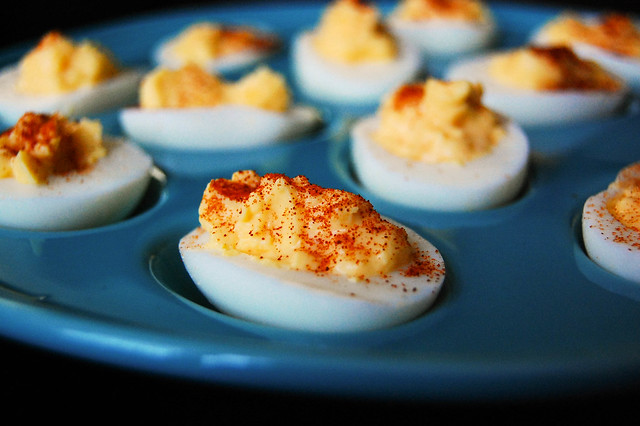One of my most recent columns for the Charleston Gazette-Mail was about deviled eggs:
It’s not a celebration in my house without the tangy, sweet addition of deviled eggs to the dinner table.
Deviled eggs — the tastier version of hard-boiled eggs that involves scooping out the yolk and mixing it with mayonnaise and mustard — serve as appetizers for every holiday meal, family event and significant milestone in the Nelson household. And, it appears I’m not alone.
In Mark Sohn’s book “Appalachian Home Cooking: History, Culture, and Recipes,” he noted a list of the most common Appalachian foods: soup beans, apple stack cake, biscuits and gravy, and other iconic staples.
A little further down the list: deviled eggs.
“No mountain dinner is complete without deviled eggs. At dinner on the grounds, they may be plucked away before the blessing is given, and at Thanksgiving dinners, even small families often serve two platters. Local markets sell deviled egg trays, and unlike yeast dinner rolls, which few cooks prepare at home, many cooks make deviled eggs,” he wrote.
These little bites, dressed in bright yellow and bold red, awaken the taste buds: salty, a little sweet, but mostly tangy, and certainly satisfying. That’s in part how they got their name.
As a culinary term, “devil” is most often used to describe dishes with spicy, tangy, hot or fried foods, first appearing in Great Britain in 1786, according to A&E’s History Channel. By 1800, “deviling” became a common verb that was used describe making food spicy or hot.
But the concept of boiling eggs, topping them with spicy sauces and serving them while entertaining goes back even further — to ancient Rome. They were seasoned with oil, wine, honey, vinegar or broth. In the 13th century, stuffing the eggs with cilantro, onion and coriander became popular in what is now Spain. By the 15th century, stuffed eggs had taken over Europe, where they were filled with raisins, cheese and herbs.
Our beloved “deviled egg” — sometimes called a “dressed egg,” made with mayonnaise (or in my household, Miracle Whip), mustard and paprika — became popular in Appalachia in the 1940s. Back then, measuring spoons weren’t big in my family — or many others in West Virginia — so our recipe for deviled eggs calls for a “smidgen” of this and a “bit” of that.
That leads to the following exercise: Mom boils the eggs and makes a yolk mixture and hands spoons to my father and me to try it.
“Too sweet,” he says. “Yeah, add more vinegar!” I say. We repeat this process approximately four or five times. It might be because we like eating the yolk mixture, or maybe it’s because we like tangier foods as we get older, but we never grant approval after just one round. And I have a sneaking suspicion this is intentional on my mother’s part, because she enjoys the tradition, too.
This simple amuse-bouche has been a staple at every major meal, even when the main course changes. Turkey for Thanksgiving? Still snacking on deviled eggs for lunch. Ham at Easter? Only if we have deviled eggs for breakfast. Potluck for family reunions? If there aren’t deviled eggs, the reunion is canceled.
And deviled eggs aren’t unique to my household or Appalachia — you can find them at high-end restaurants in big cities topped with unique ingredients — but they sure do play a role in our food culture. While other places may include them as an option, here, they’re a requirement.
So, tell me, how do you make your deviled eggs? My recipe is simple but tasty. What makes yours unique?
It’s not a celebration in my house without the tangy, sweet addition of deviled eggs to the dinner table.
Deviled eggs — the tastier version of hard-boiled eggs that involves scooping out the yolk and mixing it with mayonnaise and mustard — serve as appetizers for every holiday meal, family event and significant milestone in the Nelson household. And, it appears I’m not alone.
In Mark Sohn’s book “Appalachian Home Cooking: History, Culture, and Recipes,” he noted a list of the most common Appalachian foods: soup beans, apple stack cake, biscuits and gravy, and other iconic staples.
A little further down the list: deviled eggs.
“No mountain dinner is complete without deviled eggs. At dinner on the grounds, they may be plucked away before the blessing is given, and at Thanksgiving dinners, even small families often serve two platters. Local markets sell deviled egg trays, and unlike yeast dinner rolls, which few cooks prepare at home, many cooks make deviled eggs,” he wrote.
These little bites, dressed in bright yellow and bold red, awaken the taste buds: salty, a little sweet, but mostly tangy, and certainly satisfying. That’s in part how they got their name.
As a culinary term, “devil” is most often used to describe dishes with spicy, tangy, hot or fried foods, first appearing in Great Britain in 1786, according to A&E’s History Channel. By 1800, “deviling” became a common verb that was used describe making food spicy or hot.
But the concept of boiling eggs, topping them with spicy sauces and serving them while entertaining goes back even further — to ancient Rome. They were seasoned with oil, wine, honey, vinegar or broth. In the 13th century, stuffing the eggs with cilantro, onion and coriander became popular in what is now Spain. By the 15th century, stuffed eggs had taken over Europe, where they were filled with raisins, cheese and herbs.
Our beloved “deviled egg” — sometimes called a “dressed egg,” made with mayonnaise (or in my household, Miracle Whip), mustard and paprika — became popular in Appalachia in the 1940s. Back then, measuring spoons weren’t big in my family — or many others in West Virginia — so our recipe for deviled eggs calls for a “smidgen” of this and a “bit” of that.
That leads to the following exercise: Mom boils the eggs and makes a yolk mixture and hands spoons to my father and me to try it.
“Too sweet,” he says. “Yeah, add more vinegar!” I say. We repeat this process approximately four or five times. It might be because we like eating the yolk mixture, or maybe it’s because we like tangier foods as we get older, but we never grant approval after just one round. And I have a sneaking suspicion this is intentional on my mother’s part, because she enjoys the tradition, too.
This simple amuse-bouche has been a staple at every major meal, even when the main course changes. Turkey for Thanksgiving? Still snacking on deviled eggs for lunch. Ham at Easter? Only if we have deviled eggs for breakfast. Potluck for family reunions? If there aren’t deviled eggs, the reunion is canceled.
And deviled eggs aren’t unique to my household or Appalachia — you can find them at high-end restaurants in big cities topped with unique ingredients — but they sure do play a role in our food culture. While other places may include them as an option, here, they’re a requirement.
So, tell me, how do you make your deviled eggs? My recipe is simple but tasty. What makes yours unique?



0 comments